Antibacterial Properties of PMMA Functionalized with CuFe2O4/Cu2O/CuO Nanoparticles
Abstract
:1. Introduction
2. Materials and Methods
2.1. Synthesis of CuFe2O4/Cu2O/CuO Nanoparticles
2.2. Synthesis of CuFe2O4/Cu2O/CuO/PMMA Composite Coating
2.3. Characterization
2.4. Antibacterial Activity of CuFe2O4/Cu2O/CuO/PMMA Composite Coatings
3. Results and Discussion
3.1. Preparation and Physicochemical Characteristics of CuFe2O4/Cu2O/CuO NPs
3.2. Characterization of CuFe2O4/Cu2O/CuO/PMMA Composites
3.3. Antibacterial Activity of Composites
4. Conclusions
Author Contributions
Funding
Institutional Review Board Statement
Informed Consent Statement
Data Availability Statement
Conflicts of Interest
References
- Ali, U.; Karim, K.J.B.A.; Buang, N.A. A review of the properties and applications of poly (methyl methacrylate) (PMMA). Polym. Rev. 2015, 55, 678–705. [Google Scholar] [CrossRef]
- Frazer, R.Q.; Byron, R.T.; Osborne, P.B.; West, K.P. PMMA: An essential material in medicine and dentistry. J. Long-Term Eff. Med. Implant. 2005, 15, 629–639. [Google Scholar] [CrossRef] [PubMed] [Green Version]
- Karatepe, U.Y.; Ozdemir, T. Improving mechanical and antibacterial properties of PMMA via polyblend electrospinning with silk fibroin and polyethyleneimine towards dental applications. Bioact. Mater. 2020, 5, 510–515. [Google Scholar] [CrossRef] [PubMed]
- Hadjiev, D.; Dimitrov, D.; Martinov, M.; Sire, O. Enhancement of the biofilm formation on polymeric supports by surface conditioning. Enzym. Microb. Technol. 2007, 40, 840–848. [Google Scholar] [CrossRef]
- Fottner, A.; Nies, B.; Kitanovic, D.; Steinbrück, A.; Hausdorf, J.; Mayer-Wagner, S.; Jansson, V. In vivo evaluation of bioactive PMMA-based bone cement with unchanged mechanical properties in a load-bearing model on rabbits. J. Biomater. Appl. 2015, 30, 30–37. [Google Scholar] [CrossRef] [Green Version]
- Van Vugt, T.A.; Arts, J.J.; Geurts, J.A. Antibiotic-loaded polymethylmethacrylate beads and spacers in treatment of orthopedic infections and the role of biofilm formation. Front. Microbiol. 2019, 10, 1626. [Google Scholar] [CrossRef]
- Sh, R.N.; Azizov, A.H.; Ibadov, E.A.; Zaynalova, S.G.; Sh, R.N. The research of antibacterial properties of methyl methacrylate and methacryloyl salicylate copolymers. Azerbaijan Chem. J. 2017, 3, 17–19. [Google Scholar]
- Sun, X.; Qian, Z.; Luo, L.; Yuan, Q.; Guo, X.; Tao, L.; Wang, X. Antibacterial adhesion of poly (methyl methacrylate) modified by borneol acrylate. ACS Appl. Mater. Interfaces 2016, 8, 28522–28528. [Google Scholar] [CrossRef]
- Patel, S.R.; Ramanujam, C.L.; Zgonis, T. A Guide to Using Antibiotic-Loaded PMMA Beads and Spacers in the Diabetic Foot. Diabet. Foot 2019, 32, 5. Available online: https://www.hmpgloballearningnetwork.com/site/podiatry/guide-using-antibiotic-loaded-pmma-beads-and-spacers-diabetic-foot (accessed on 16 May 2022).
- Nam, K.Y. Characterization and antifungal activity of the modified PMMA denture base acrylic: Nanocomposites impregnated with gold, platinum, and silver nanoparticles. In Nanobiomaterials in Dentistry; William Andrew Publishing: Norwich, NY, USA, 2016; pp. 309–336. [Google Scholar]
- Sathya, S.; Murthy, P.S.; Das, A.; Sankar, G.G.; Venkatnarayanan, S.; Pandian, R.; Venugopalan, V.P. Marine antifouling property of PMMA nanocomposite films: Results of laboratory and field assessment. Int. Biodeterior. Biodegrad. 2016, 114, 57–66. [Google Scholar] [CrossRef]
- Yang, D.H.; Yoon, G.H.; Shin, G.J.; Kim, S.H.; Rhee, J.M.; Khang, G.; Lee, H.B. Surface and chemical properties of surface-modified UHMWPE powder and mechanical and thermal properties of its impregnated PMMA bone cement V. Effect of silane coupling agent on the surface modification of UHMWPE powder. Macromol. Res. 2005, 13, 120–127. [Google Scholar] [CrossRef]
- Shi, Z.; Neoh, K.G.; Kang, E.T.; Wang, W. Antibacterial and mechanical properties of bone cement impregnated with chitosan nanoparticles. Biomaterials 2006, 27, 2440–2449. [Google Scholar] [CrossRef] [PubMed]
- Zidan, S.; Silikas, N.; Alhotan, A.; Haider, J.; Yates, J. Investigating the mechanical properties of ZrO2-impregnated PMMA nanocomposite for denture-based applications. Materials 2019, 12, 1344. [Google Scholar] [CrossRef] [PubMed] [Green Version]
- Zidan, S.; Silikas, N.; Haider, J.; Alhotan, A.; Jahantigh, J.; Yates, J. Assessing Tensile bond strength between denture teeth and nano-zirconia impregnated PMMA denture base. Int. J. Nanomed. 2020, 15, 9611. [Google Scholar] [CrossRef]
- Siddiqui, M.N.; Redhwi, H.H.; Vakalopoulou, E.; Tsagkalias, I.; Ioannidou, M.D.; Achilias, D.S. Synthesis, characterization and reaction kinetics of PMMA/silver nanocomposites prepared via in situ radical polymerization. Eur. Polym. J. 2015, 72, 256–269. [Google Scholar] [CrossRef]
- Wentao, W.; Tao, Z.; Bulei, S.; Tongchang, Z.; Qicheng, Z.; Fan, W.; Yi, S. Functionalization of polyvinyl alcohol composite film wrapped in am-ZnO@CuO@Au nanoparticles for antibacterial application and wound healing. Appl. Mater. Today 2019, 17, 36–44. [Google Scholar] [CrossRef]
- Zhou, Z.; Li, B.; Liu, X.; Li, Z.; Zhu, S.; Liang, Y.; Wu, S. Recent progress in photocatalytic antibacterial. ACS Appl. Bio Mater. 2021, 4, 3909–3936. [Google Scholar] [CrossRef]
- Sodagar, A.; Khalil, S.; Kassaee, M.Z.; Shahroudi, A.S.; Pourakbari, B.; Bahador, A. Antimicrobial properties of poly (methyl methacrylate) acrylic resins incorporated with silicon dioxide and titanium dioxide nanoparticles on cariogenic bacteria. J. Orthod. Sci. 2016, 5, 7. [Google Scholar] [CrossRef]
- Garcia-Muñoz, P.; Fresno, F.; Peña O’Shea, V.A.; Keller, N. Ferrite materials for photoassisted environmental and solar fuels applications. Heterog. Photocatal. 2020, 378, 107–162. [Google Scholar] [CrossRef]
- Renuka, L.; Anantharaju, K.S.; Vidya, Y.S.; Nagabhushana, H.; Uma, B.; Malini, S.; Koppad, P. Porous network ZrO2/ZnFe2O4 nanocomposite with heterojunction towards industrial water purification under sunlight: Enhanced charge separation and elucidation of photo-mechanism. Ceram. Int. 2021, 47, 14845–14861. [Google Scholar] [CrossRef]
- Ma, A.; Gao, Y.; Zhang, D.; Hou, X. Use of m-BiVO4/ZnFe2O4 composite materials for enhanced photocatalytic properties. Surf. Innov. 2020, 9, 139–148. [Google Scholar] [CrossRef]
- Ramadan, R.; Ahmed, M.K.; Uskoković, V. Magnetic, microstructural and photoactivated antibacterial features of nanostructured Co–Zn ferrites of different chemical and phase compositions. J. Alloys Compd. 2021, 856, 157013. [Google Scholar] [CrossRef]
- Elayakumar, K.; Manikandan, A.; Dinesh, A.; Thanrasu, K.; Raja, K.K.; Kumar, R.T.; Baykal, A. Enhanced magnetic property and antibacterial biomedical activity of Ce3+ doped CuFe2O4 spinel nanoparticles synthesized by sol-gel method. J. Magn. Magn. Mater. 2019, 478, 140–147. [Google Scholar] [CrossRef]
- Akbar Hosseini, S. Low-cost and eco-friendly viable approach for synthesis of thulium doped copper ferrite nanoparticles using starch. J. Mater. Sci. Mater. Electron. 2016, 27, 7433–7437. [Google Scholar] [CrossRef]
- Masunga, N.; Mmelesi, O.K.; Kefeni, K.K.; Mamba, B.B. Recent advances in copper ferrite nanoparticles and nanocomposites synthesis, magnetic properties and application in water treatment. J. Environ. Chem. Eng. 2019, 7, 103179. [Google Scholar] [CrossRef]
- Özdemir, Z.G.; Kılıç, M.; Karabul, Y.; Mısırlıoğlu, B.S.; Çakır, Ö.; Kahya, N.D. A transition in the electrical conduction mechanism of CuO/CuFe2O4 nanocomposites. J. Electroceramics 2020, 44, 1–15. [Google Scholar] [CrossRef]
- Boepple, M.; Zhu, Z.; Hu, X.; Weimar, U.; Barsan, N. Impact of heterostructures on hydrogen sulfide sensing: Example of core-shell CuO/CuFe2O4 nanostructures. Sens. Actuators B Chem. 2020, 321, 128523. [Google Scholar] [CrossRef]
- Chapelle, A.; El Younsi, I.; Vitale, S.; Thimont, Y.; Nelis, T.; Presmanes, L.; Tailhades, P. Improved semiconducting CuO/CuFe2O4 nanostructured thin films for CO2 gas sensing. Sens. Actuators B Chem. 2014, 204, 407–413. [Google Scholar] [CrossRef] [Green Version]
- De, S.; Venkataramani, N.; Prasad, S.; Dusane, R.O.; Presmanes, L.; Thimont, Y.; Barnabé, A. Ethanol and hydrogen gas-sensing properties of CuO–CuFe2O4 nanostructured thin films. IEEE Sens. J. 2018, 18, 6937–6945. [Google Scholar] [CrossRef] [Green Version]
- Dhiwahar, A.T.; Maruthamuthu, S.; Marnadu, R.; Sundararajan, M.; Manthrammel, M.A.; Shkir, M.; Reddy, V.R.M. Improved photocatalytic degradation of rhodamine B under visible light and magnetic properties using microwave combustion grown Ni doped copper ferrite spinel nanoparticles. Solid State Sci. 2021, 113, 106542. [Google Scholar] [CrossRef]
- Liu, J.M.; Lu, Y.H.; Xu, Z.F.; Wang, R.X.; Yan, H.C.; Li, X. Effect of citric acid-to-nitrate ratio on combustion synthesis of CuFe2O4 for sodium-ion storage. J. Mater. Sci. Mater. Electron. 2021, 32, 94–101. [Google Scholar] [CrossRef]
- Zhang, Y.; Chen, Y.; Kang, Z.V.; Gao, X.; Zeng, X.; Liu, M.; Yang, D.P. Waste eggshell membrane-assisted synthesis of magnetic CuFe2O4 nanomaterials with multifunctional properties (adsorptive, catalytic, antibacterial) for water remediation. Colloids Surf. A Physicochem. Eng. Asp. 2021, 612, 125874. [Google Scholar] [CrossRef]
- Li, Q.; Yong, C.; Cao, W.; Wang, X.; Wang, L.; Zhou, J.; Xing, X. Fabrication of charge reversible graphene oxide-based nanocomposite with multiple antibacterial modes and magnetic recyclability. J. Colloid Interface Sci. 2018, 511, 285–295. [Google Scholar] [CrossRef]
- Bakina, O.V.; Glazkova, E.A.; Svarovskaya, N.V.; Rodkevich, N.G.; Lerner, M.I. «Janus»-like Cu-Fe bimetallic nanoparticles with high antibacterial activity. Mater. Lett. 2019, 242, 187–190. [Google Scholar] [CrossRef]
- Lerner, M.I.; Pervikov, A.V.; Glazkova, E.A.; Svarovskaya, N.V.; Lozhkomoev, A.S.; Psakhie, S.G. Structures of binary metallic nanoparticles produced by electrical explosion of two wires from immiscible elements. Powder Technol. 2016, 288, 371–378. [Google Scholar] [CrossRef]
- Schorne-Pinto, J.; Cassayre, L.; Presmanes, L.; Barnabé, A. Insights on the stability and cationic nonstoichiometry of CuFeO2 delafossite. Inorg. Chem. 2019, 58, 6431–6444. [Google Scholar] [CrossRef] [PubMed] [Green Version]
- Atacan, K. CuFe2O4/reduced graphene oxide nanocomposite decorated with gold nanoparticles as a new electrochemical sensor material for ʟ-cysteine detection. J. Alloys Compd. 2019, 791, 391–401. [Google Scholar] [CrossRef]
- Thakare, P.S.; Padole, P.R.; Bodade, A.B.; Chaudhari, G.N. Microstructural and Antifungal Properties of Silver Substituted Copper Ferrite Nanopowder Synthesized By Sol-Gel Method. Indo Am. J. Pharm. Sci. 2018, 5, 52–63. [Google Scholar] [CrossRef]
- Svarovskaya, N.V.; Bakina, O.V.; Pervikov, A.V.; Rubtsov, K.V.; Lerner, M.I. Electrical Explosion of Wires for Manufacturing Bimetallic Antibacterial Ti-Ag and Fe-Ag Nanoparticles. Russ. Phys. J. 2020, 62, 1580–1586. [Google Scholar] [CrossRef]
- Deng, X.; Huang, Z.; Wang, W.; Davé, R.N. Investigation of nanoparticle agglomerates properties using Monte Carlo simulations. Adv. Pow. Technol. 2016, 27, 1971–1979. [Google Scholar] [CrossRef] [Green Version]
- Holubnycha, V.; Myronov, P.; Bugaiov, V.; Opanasyuk, A.; Dobrozhan, O.; Yanovska, A.; Pogorielov, M.; Kalinkevichet, O. Effect of ultrasound treatment on chitosan-silver nanoparticles antimicrobial activity. In Proceedings of the 2018 IEEE 8th International Conference Nanomaterials: Application & Properties (NAP), Zatoka, Ukraine, 9–14 September 2018; IEEE: Piscataway, NJ, USA, 2018; pp. 1–4. [Google Scholar] [CrossRef]
- Sohail, Y.; Liaquat, A.; Zafar, M.F.; Ul-Haq, N. Impedance spectroscopy and investigation of conduction mechanism in reduced graphene/CuFe2O4 nanocomposites. Appl. Phys. A 2021, 127, 423. [Google Scholar] [CrossRef]
- Matsuura, K.; Kuboyama, K.; Ougizawa, T. Effect of tacticity of poly (methyl methacrylate) on interfacial region with silica in polymer nanocomposite. Polym. Eng. Sci. 2021, 61, 77–84. [Google Scholar] [CrossRef]
- Abutalib, M.M.; Rajeh, A. Influence of Fe3O4 nanoparticles on the optical, magnetic and electrical properties of PMMA/PEO composites: Combined FT-IR/DFT for electrochemical applications. J. Organomet. Chem. 2020, 920, 121348. [Google Scholar] [CrossRef]
- Alghunaim, N.S. In situ synthesis and investigation poly (methyl methacrylate)/polycarbonate nanocomposites incorporated with copper oxide nanoparticles. Results Phys. 2020, 19, 103368. [Google Scholar] [CrossRef]
- Abutalib, M.M. Insights into the structural, optical, thermal, dielectric, and electrical properties of PMMA/PANI loaded with graphene oxide nanoparticles. Phys. B Condens. Matter 2019, 29, 55219. [Google Scholar] [CrossRef]
- Nakanishi, E.Y.; Palacios, J.H.; Godbout, S.; Fournel, S. Interaction between Biofilm Formation, Surface Material and Cleanability Considering Different Materials Used in Pig Facilities—An Overview. Sustainability 2021, 13, 5836. [Google Scholar] [CrossRef]
- Tarrío-Saavedra, J.; López-Beceiro, J.; Naya, S.; Francisco-Fernández, M.; Artiaga, R. Simulation study for generalized logistic function in thermal data modeling. J. Therm. Anal. Calorim. 2014, 118, 1253–1268. [Google Scholar] [CrossRef]
- Wekwejt, M.; Chen, S.; Kaczmarek-Szczepańska, B.; Nadolska, M.; Łukowicz, K.; Pałubicka, A.; Zieliński, A. Nanosilver-loaded PMMA bone cement doped with different bioactive glasses–evaluation of cytocompatibility, antibacterial activity, and mechanical properties. Biomater. Sci. 2021, 9, 3112–3126. [Google Scholar] [CrossRef]
- Giti, R.; Zomorodian, K.; Firouzmandi, M.; Zareshahrabadi, Z.; Rahmannasab, S. Antimicrobial activity of thermocycled polymethyl methacrylate resin reinforced with titanium dioxide and copper oxide nanoparticles. Int. J. Dent. 2021, 2021, 6690806. [Google Scholar] [CrossRef]
- Li, Z.P.; You, S.; Mao, R.; Xiang, J.; Deng, A.C.H.; Shen, J.; Qi, X. Architecting polyelectrolyte hydrogels with Cu-assisted polydopamine nanoparticles for photothermal antibacterial therapy. Mater. Today Bio 2022, 15, 100264. [Google Scholar] [CrossRef]
- Hassanzadeh-Afruzi, F.; Amiri-Khamakani, Z.; Bahrami, S.; Reza Ahghari, M.; Maleki, A. Assessment of catalytic and antibacterial activity of biocompatible agar supported ZnS/CuFe2O4 magnetic nanotubes. Sci. Rep. 2022, 12, 4503. [Google Scholar] [CrossRef] [PubMed]
- Gheidari, D.; Mehrdad, M.; Maleki, S.; Hosseinic, S. Synthesis and potent antimicrobial activity of CoFe2O4 nanoparticles under visible light. Heliyon 2020, 6, e05058. [Google Scholar] [CrossRef] [PubMed]

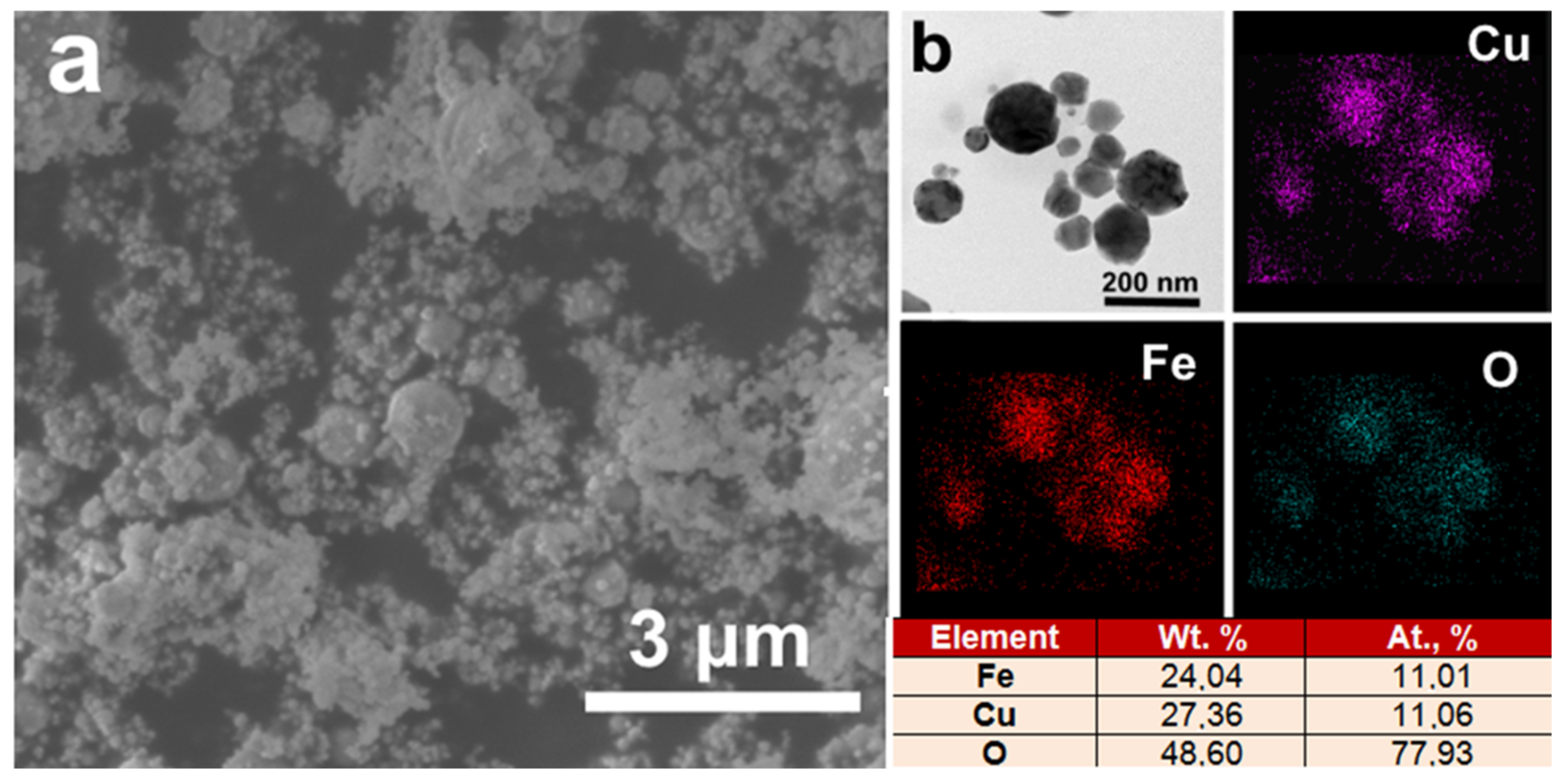
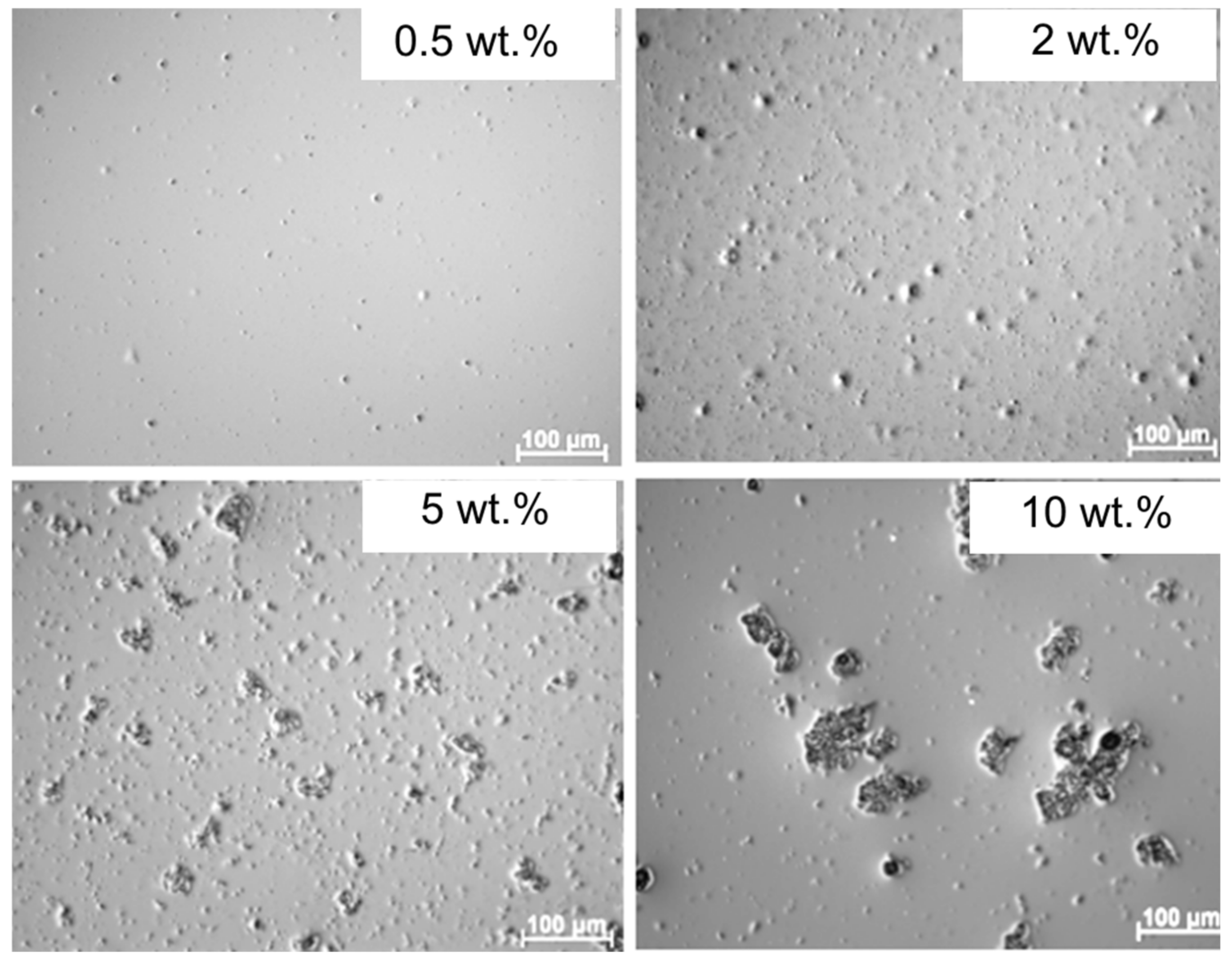
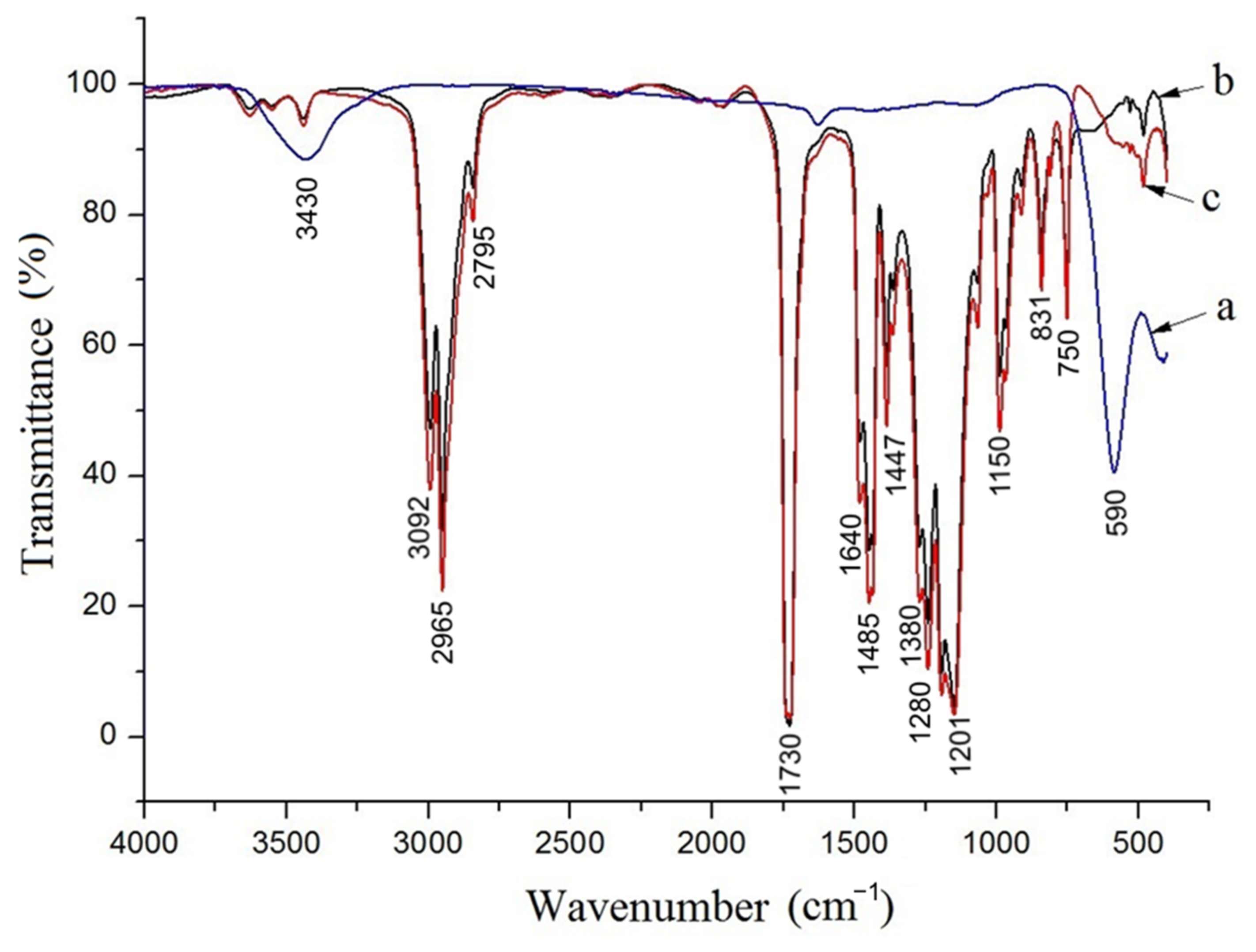
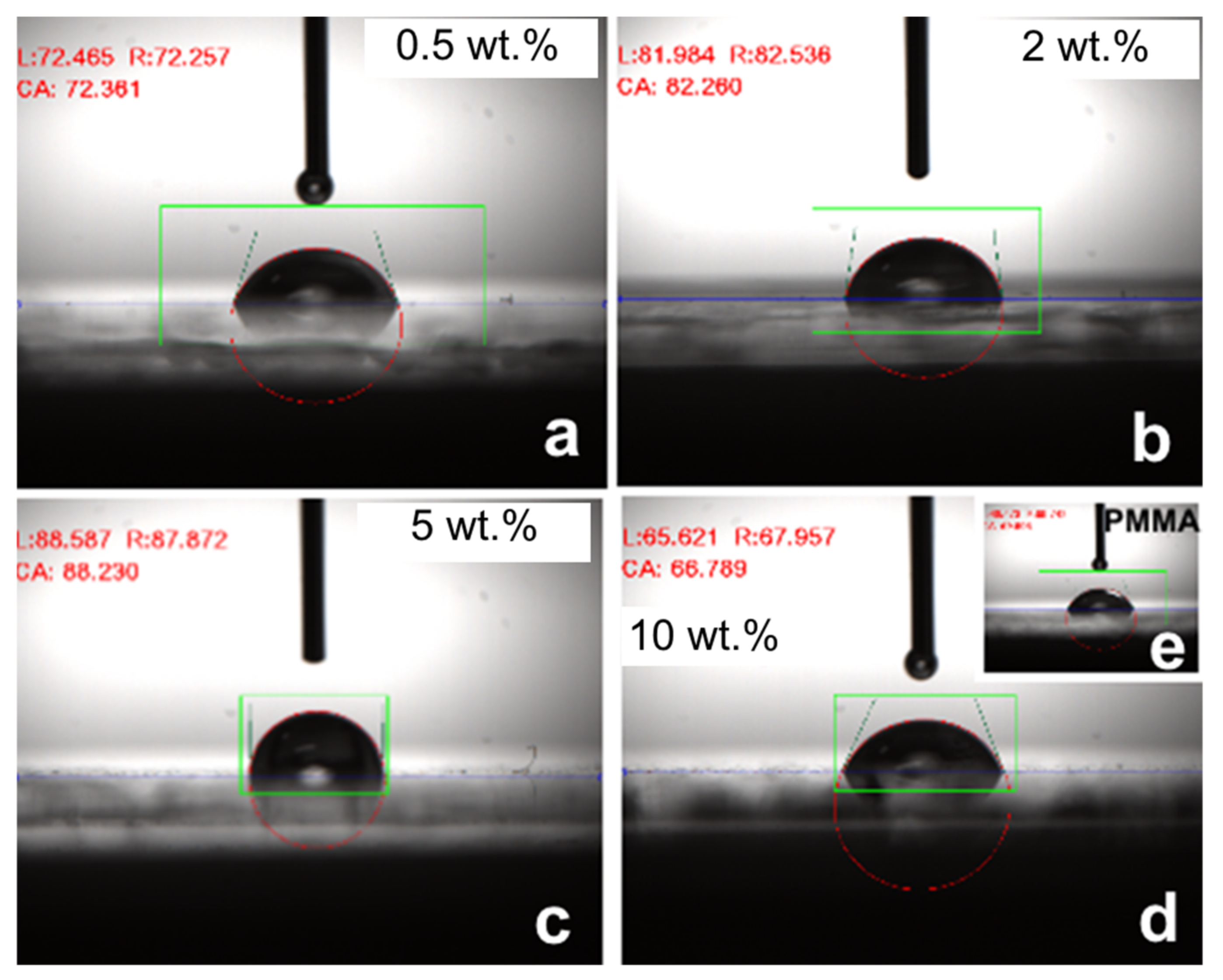
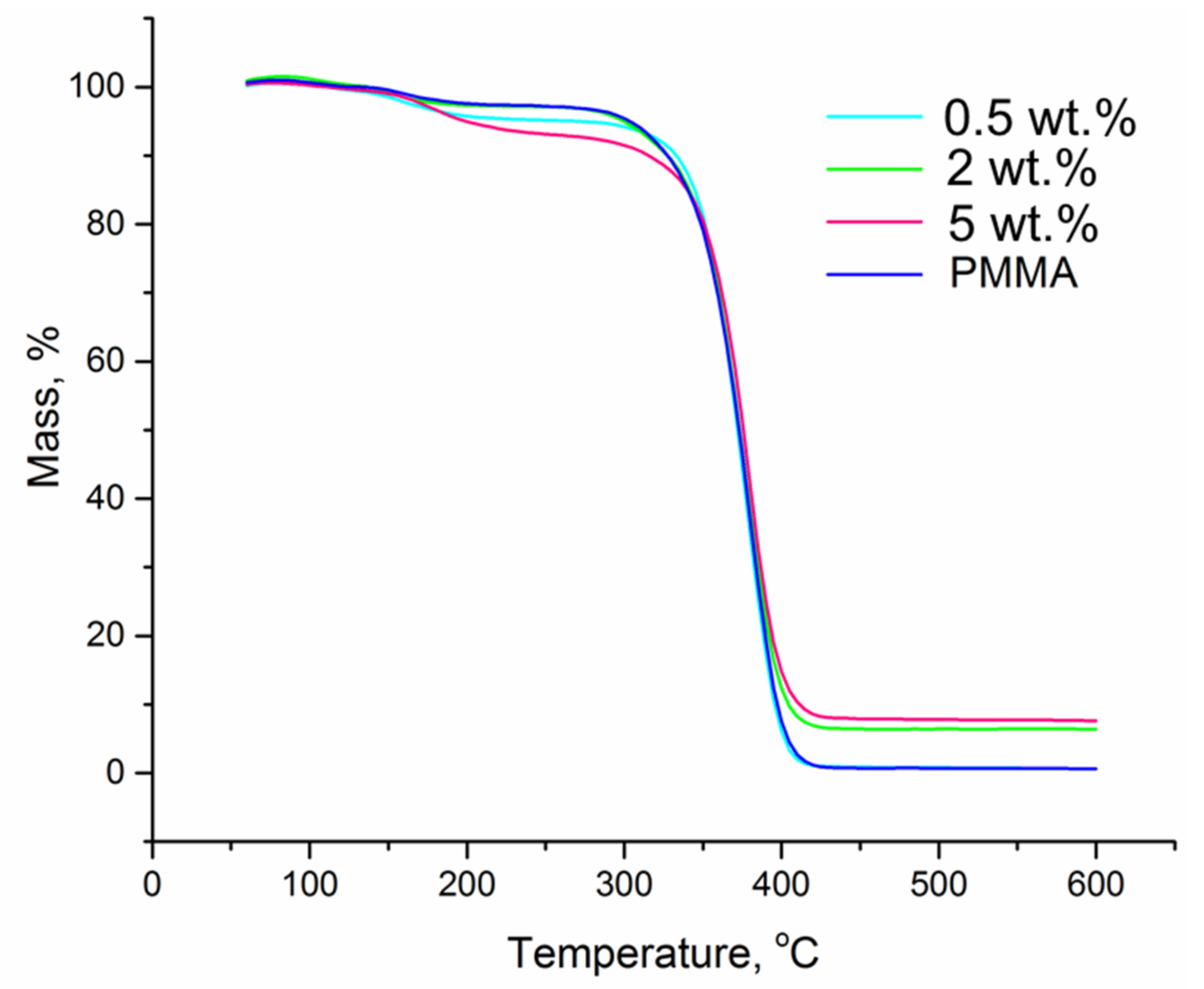
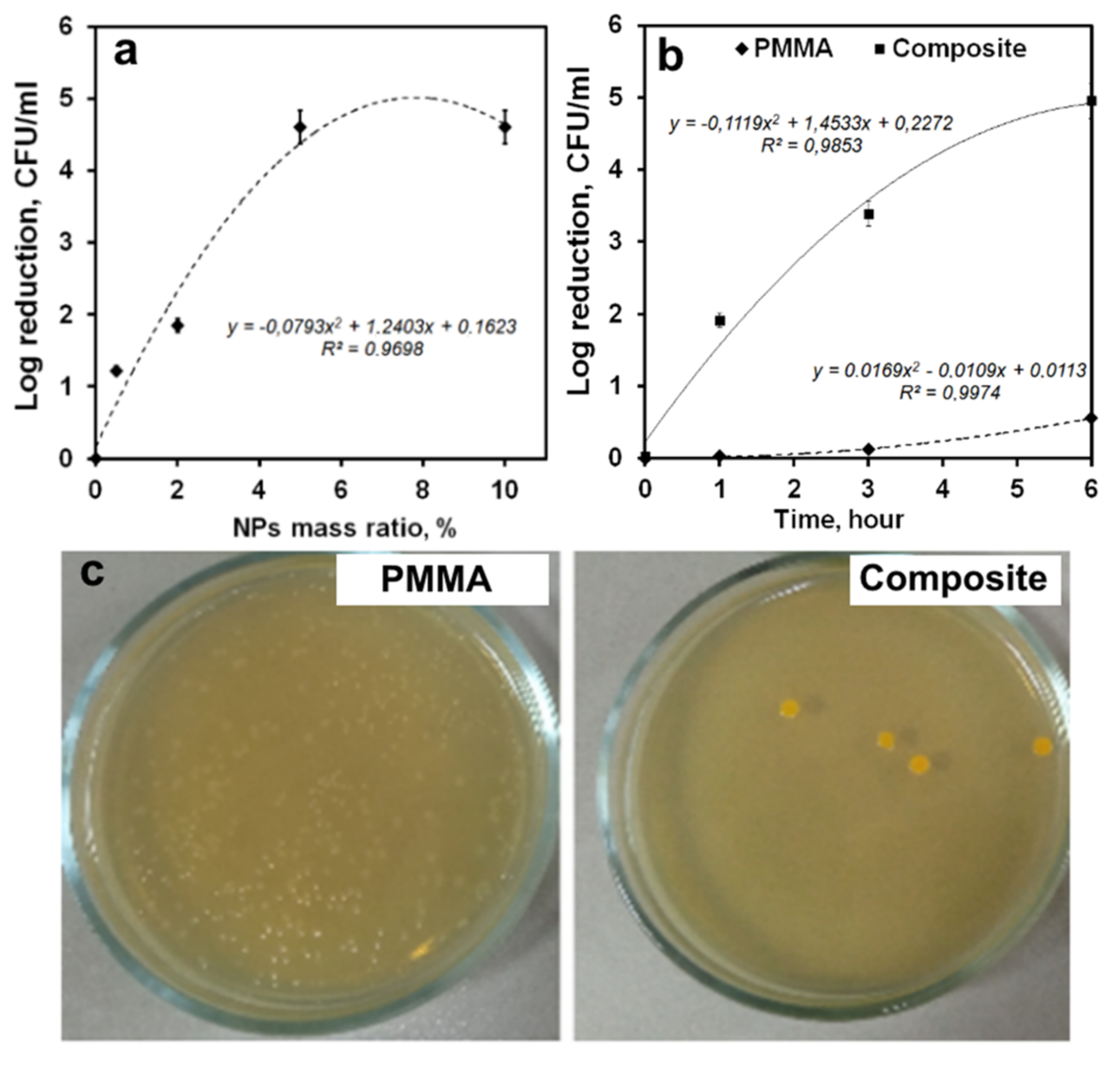

| Sample | PMMA | 0.5 wt.% NPs | 2 wt.% NPs | 5 wt.% NPs | |
|---|---|---|---|---|---|
| Stage I | M | 5.70 | 4.96 | 5.33 | 10.71 |
| θ | 156. | 150 | 154 | 173 | |
| b1 | 18.20 | 9.65 | 16.7 | 16.2 | |
| τ | 1.72 | 3.58 | 4.41 | 5.12 | |
| Stage II | M | 94.10 | 94.90 | 88.30 | 82.07 |
| θ | 377.00 | 378 | 378 | 378 | |
| b | 15.1 | 17.89 | 16.48 | 13.60 | |
| τ | 0.11 | 0.10 | 0.27 | 0.49 | |
| R2 | 0.9999 | 0.9999 | 0.9999 | 0.9999 | |
| Sample | Colony-Forming Unit, CFU/mL | R *, % | ||||
|---|---|---|---|---|---|---|
| 1 h | 3 h | 6 h | 1 h | 3 h | 6 h | |
| E. coli | ||||||
| PMMA | 6.63 × 104 ± 0.45 × 104 | 4.10 × 104 ± 0.06 × 104 | 1.47 × 104 ± 0.12 × 104 | 33.7 | 59.0 | 85.3 |
| 0.5 wt.% | 2.67 × 104 ± 0.12 × 104 | 1.9 × 104 ± 0.1 × 104 | 1.30 × 103 ± 0.02 × 103 | 73.3 | 81.0 | 98.7 |
| 2 wt.% | 1.03 × 104 ± 0.12 × 104 | 0.23 × 104 ± 0.06 × 104 | 0.10 × 103 ± 0.00 × 103 | 89.7 | 97.7 | 99.9 |
| 5 wt.% | 0.70 × 103 ± 0.12 × 103 | 0 ± 0 | 0 ± 0 | 99.3 | 100 | 100 |
| 10 wt.% | 5.17 × 102 ± 0.12 × 102 | 0 ± 0 | 0 ± 0 | 99.5 | 100 | 100 |
| MRSA | ||||||
| PMMA | 8.33 × 104 ± 0.40 × 104 | 6.83 × 104 ± 0.11 × 104 | 2.50 × 104 ± 0.09 × 104 | 16.7 | 31.7 | 75.0 |
| 0.5 wt.% | 9.20 × 103 ± 0.50 × 103 | 2.40 × 103 ± 0.40 × 103 | 0.33 × 103 ± 0.05 × 103 | 90.8 | 97.6 | 99.7 |
| 2 wt.% | 2.33 × 103 ± 0.31 × 103 | 5.70 × 102 ± 0.05 × 102 | 0.87 × 102 ± 0.08 × 102 | 97.7 | 99.4 | 99.9 |
| 5 wt.% | 1.10 × 103 ± 0.04 × 103 | 39.67 ± 1.52 | 0 ± 0 | 98.9 | 99.9 | 100 |
| 10 wt.% | 5.17 × 102 ± 0.12 × 102 | 0 ± 0 | 0 ± 0 | 99.5 | 100 | 100 |
Publisher’s Note: MDPI stays neutral with regard to jurisdictional claims in published maps and institutional affiliations. |
© 2022 by the authors. Licensee MDPI, Basel, Switzerland. This article is an open access article distributed under the terms and conditions of the Creative Commons Attribution (CC BY) license (https://creativecommons.org/licenses/by/4.0/).
Share and Cite
Glazkova, E.; Bakina, O.; Rodkevich, N.; Mosunov, A.; Evstigneev, M.; Evstigneev, V.; Klimenko, V.; Lerner, M. Antibacterial Properties of PMMA Functionalized with CuFe2O4/Cu2O/CuO Nanoparticles. Coatings 2022, 12, 957. https://doi.org/10.3390/coatings12070957
Glazkova E, Bakina O, Rodkevich N, Mosunov A, Evstigneev M, Evstigneev V, Klimenko V, Lerner M. Antibacterial Properties of PMMA Functionalized with CuFe2O4/Cu2O/CuO Nanoparticles. Coatings. 2022; 12(7):957. https://doi.org/10.3390/coatings12070957
Chicago/Turabian StyleGlazkova, Elena, Olga Bakina, Nikolay Rodkevich, Andrey Mosunov, Maxim Evstigneev, Vladislav Evstigneev, Viktor Klimenko, and Marat Lerner. 2022. "Antibacterial Properties of PMMA Functionalized with CuFe2O4/Cu2O/CuO Nanoparticles" Coatings 12, no. 7: 957. https://doi.org/10.3390/coatings12070957
APA StyleGlazkova, E., Bakina, O., Rodkevich, N., Mosunov, A., Evstigneev, M., Evstigneev, V., Klimenko, V., & Lerner, M. (2022). Antibacterial Properties of PMMA Functionalized with CuFe2O4/Cu2O/CuO Nanoparticles. Coatings, 12(7), 957. https://doi.org/10.3390/coatings12070957








